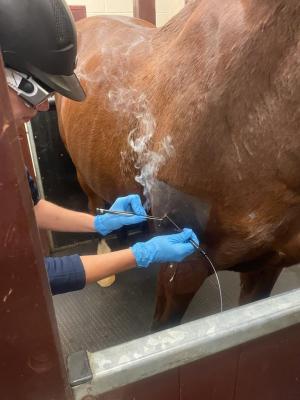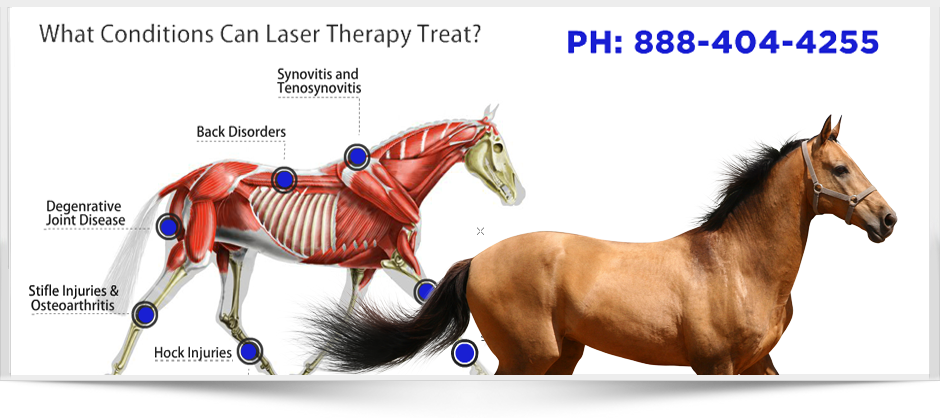Equine Therapy Programs: Transforming Lives One Experience each time
Equine Therapy Programs: Transforming Lives One Experience each time
Blog Article
Just How Laser Therapy in Equine Therapy Is Transforming Vet Care for Equines
Laser treatment has arised as a transformative approach in equine veterinary care, providing a non-invasive solution that quickens healing and improves total health and wellness. Leveraging specific light wavelengths, this advanced treatment promotes mobile regeneration, decreases swelling, and minimizes pain. Its effectiveness expands from bone and joint injuries to persistent conditions like osteo arthritis, substantially boosting mobility and life quality for equines. The mobility and convenience of laser treatment gadgets further underscore their expanding necessity amongst vets. As we explore the elaborate auto mechanics and real-world successes, the extensive influence on equine medical methods ends up being progressively obvious.

Recognizing Laser Treatment
Recognizing laser treatment is necessary for valuing its role in equine therapy. Laser treatment, likewise recognized as photobiomodulation, involves the application of specific wavelengths of light to cells, which can lead to various organic results. This healing technique utilizes the power of light energy to pass through the skin and underlying tissues, boosting mobile processes and boosting tissue repair.
The modern technology behind laser therapy is based in the principle of photochemistry, where photons are absorbed by chromophores within cells, bring about enhanced ATP manufacturing and inflection of reactive oxygen types. This, in turn, advertises cellular spreading, minimizes swelling, and speeds up healing. Veterinary professionals make use of different sorts of lasers, consisting of low-level lasers (LLLT) and high-power Class IV lasers, depending on the details healing purposes and the nature of the equine condition being treated.
Different laser wavelengths and power setups are thoroughly selected to target numerous cells depths and attain desired professional end results. Safety methods are vital, as improper use can lead to thermal damages or suboptimal therapeutic results. Thus, a detailed understanding of laser treatment's mechanisms and applications is important for its reliable implementation in equine veterinary technique.
Advantages for Equine Wellness
The myriad advantages of laser therapy for equine health and wellness incorporate boosted healing, pain reduction, and enhanced movement. This innovative therapy modality leverages specific wavelengths of light to pass through tissues, promoting cellular function and advertising fast cells fixing. The non-invasive nature of laser therapy makes sure marginal stress and anxiety and pain for the steed, helping with a smoother healing process.

By reducing swelling and discomfort, and boosting tissue fixing, laser therapy assists in recovering joint function and muscle adaptability. Thus, laser treatment stands as a transformative device in modern equine vet treatment.
Common Conditions Treated
Laser therapy has become a functional therapy choice for a variety of common equine problems. Among these, musculoskeletal injuries are specifically open to laser therapy. Soft tissue injuries, such as tendonitis and tendon stress, gain from the anti-inflammatory and analgesic effects of laser treatments, which accelerate recovery and reduce pain. In addition, laser treatment is effective for problems like osteoarthritis, where it helps alleviate joint swelling and advertise cells repair.
Wound monitoring is another area where laser treatment has shown significant guarantee. Persistent wounds or slow-healing abscess can be specifically tough in equines, yet laser treatment enhances mobile regeneration and improves blood flow, therefore accelerating the recovery process. Laser therapies have been efficiently utilized in managing unguis problems such as laminitis and abscesses, minimizing pain and advertising quicker recuperation.
Equine professional athletes frequently struggle with performance-related concerns like muscle mass pain and stress cracks. Laser therapy aids in reducing muscular tissue tiredness and quickens the recuperation of micro-injuries, therefore making certain that horses return to peak performance faster. By resolving these diverse conditions, laser therapy is changing the landscape of veterinary treatment, supplying a non-invasive, effective choice to traditional treatments.
Innovation Behind Laser Treatment

Laser devices utilized in vet medication usually utilize low-level laser therapy (LLLT) or chilly laser treatment. Unlike high-powered medical lasers, these gadgets operate at lower power levels, optimizing therapeutic benefits while minimizing thermal damages. The power from the laser light boosts adenosine triphosphate (ATP) manufacturing, boosts mobile metabolic rate, and accelerates tissue repair service processes.
Modern laser treatment devices for equine therapy is made with flexible settings to cater to the details demands of different tissues and conditions. Furthermore, improvements in laser technology have actually led to the development of mobile, portable tools, making it simpler for vets to offer therapy in a variety of settings, from centers to stables.
Success Stories and Study
Showcasing the concrete advantages of laser treatment, countless success stories and instance studies illuminate its transformative impact on equine health and wellness. One such situation involves a purebred racehorse struggling with chronic tendonitis. Traditional treatments generated marginal improvement, but after integrating laser therapy into the regimen, the equine displayed significant decreases in swelling and pain within weeks, ultimately going back to competitive auto racing.
Another engaging instance includes a dressage her comment is here steed detected with extreme neck and click reference back pain, limiting its efficiency. A veterinary group used low-level laser therapy (LLLT) to target the swollen locations, causing significant renovation in versatility and a remarkable reduction in pain. Over numerous sessions, the steed restored its peak kind, showcasing the effectiveness of laser therapy in dealing with bone and joint issues.
In addition, a study conducted at a leading equine clinic examined 50 steeds with numerous soft cells injuries treated with laser treatment. The results stood out: 85% of the steeds showed accelerated healing times and boosted wheelchair. These instances highlight the versatility and performance of laser therapy in equine medication, using a non-invasive, scientifically-backed technique to enhancing healing and efficiency in steeds.
Final Thought
Laser treatment is revolutionizing equine veterinary treatment by supplying a non-invasive treatment that increases healing, reduces inflammation, and alleviates pain. With its efficiency in treating an array of problems, from musculoskeletal injuries to chronic disorders like osteo arthritis, this technology dramatically boosts equine wellness and mobility. The portability and adaptability of laser treatment additionally highlight its transformative effect on vet methods, solidifying helpful hints its duty as an essential device in modern equine medical care.
Report this page